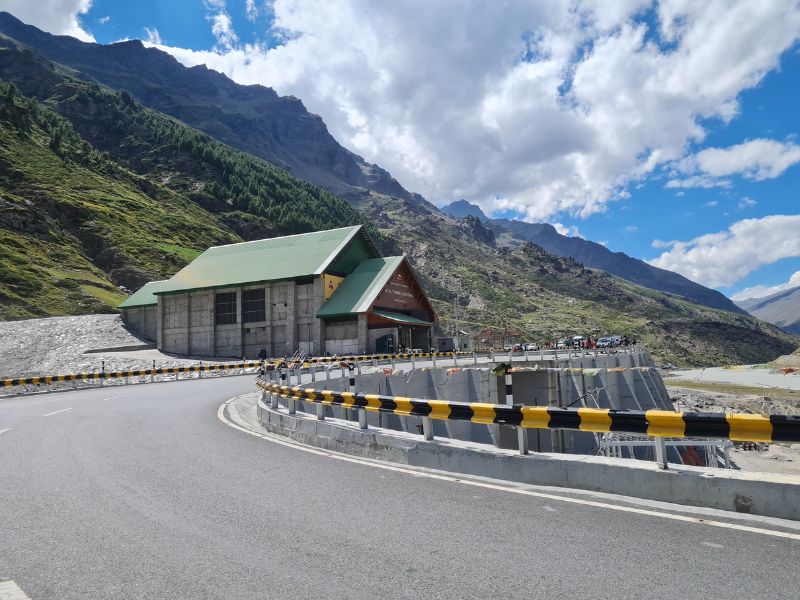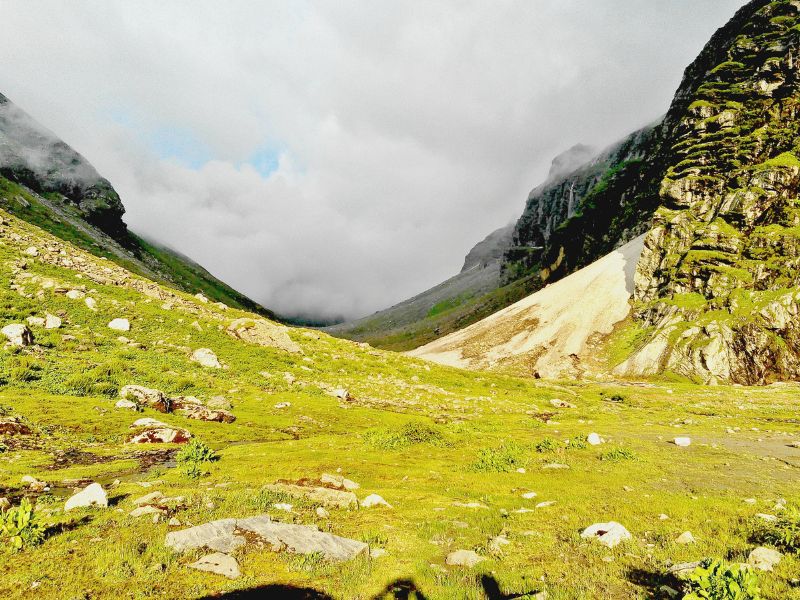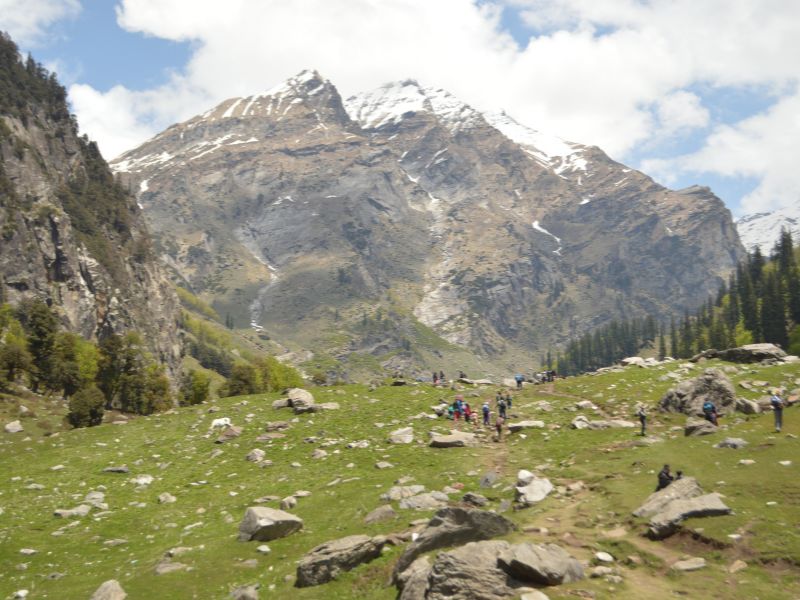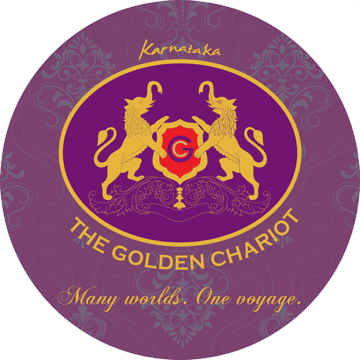
Approved Adventure Tour Operator
Monks on Wheels in association with Justwravel brings to you the Hampta Pass trek in Himachal Pradesh that offers a stunning display of nature’s diversity, showcasing lush green valleys on one side and stark, barren mountains on the other. This trek provides a unique experience, blending the vibrancy of blooming spring flowers with the rugged terrain of jagged landscapes. The Hampta Pass serves as a vantage point, offering breathtaking views of two contrasting regions: the expansive, vegetation-free Lahaul Valley to the north and the verdant, forested Kullu Valley to the south. Although the Hampta Pass trek spans only 26 km, the ever-changing landscape makes it feel like a journey through all four seasons. You’ll experience the warmth of golden sunlight, the beauty of spring flowers, and the chill of the Lahaul-Spiti deserts.
The Hampta Pass trek trail takes you through alpine forests where Maple, Birch, Oak, and Deodar trees rustle their leaves in sync with the cool breeze. Meadows with waving stalks of green beckon you closer, enticing you to keep walking until you reach the silver streams of water gurgling through the same paths that you are walking upon. The snowline commences after walking for a few miles where a steep ascent leads you to the Hampta pass where majestic mountains stand tall, overlooking narrow valleys speckled with wildflowers. The contrast of the delicate flower petals against the rugged mountains is breathtaking, showcasing nature’s dramatic beauty. The trek begins in Manali, from where you drive to Jobra, the base of the Hampta Pass trek. The drive itself is an adventure, with 42 hairpin bends offering panoramic views of the Kullu Valley. As you approach Jobra, the heat of Manali dissipates, replaced by a cool breeze and the flowing Rani Nallah River. Upon reaching Jobra, the trek leader conducts a briefing session, and then you set off to Chika, the first campsite, nestled at an altitude of 10,000 ft in the Pir Panjal ranges.
The trek from Jobra to Chika is a gentle 2 km hike, passing through pine, green maple, and silver birch trees. The trail is rich in water resources, with the Rani Nallah river meandering through the meadow where you set up camp for the night. After an early breakfast, the trek continues to Balu ka Ghera, covering 9 km of green pastures, boulders, and loose rocks. The cascading streams of the Jwara river add a pearly glow to the green landscape, while the mighty Dhauladhar ranges peek from behind, enhancing the scenery. The ascent from Jobra to Balu ka Ghera is moderate, with the terrain becoming more challenging as you progress. Balu ka Ghera, translating to “sandy plain,” lives up to its name with its coarse sand topography. The campsite is set amidst wildflowers, birch, and rhododendron trees, contrasting with the bare ground. The next day, the trek to Sia Goru involves a steep uphill trail that is both challenging and rewarding, with significant altitude gain in six hours. The trail features slanting slopes, a shallow lake, and snow stretches, culminating in three steep ridges before revealing the Hampta Pass.
The Hampta Pass acts as a gateway between the Lahaul and Kullu Valleys, offering a striking crossover. The pass resembles a narrow valley blooming with flowers, overlooked by mountains with silver streams flowing through the meadows. The trek from Balu ka Ghera to Hampta Pass covers 3 km and is of moderate difficulty, with a gradual steep ascent followed by a flat walk descending towards Sia Goru, our next campsite. Nestled at an altitude of 12,900 ft, Sia Goru is an Eden-like landscape with river streams and is one of the best high-altitude campsites. The next day, the descent towards Chhatru involves traversing rocky sedimentation from glaciers. The trail to Chhatru is moderate, with inclines and loose rocks. The lack of vegetation contrasts with the green canopies previously witnessed, showcasing the Hampta Pass trek’s ability to surprise with its ever-changing landscape.
Reaching Chhatru feels rewarding, and from there, we drive to Chandratal, one of the highlights of the Hampta Pass trek. This crescent moon-shaped lake in the Lahaul-Spiti region is a must-visit, located just 45 km from Chhatru. After visiting Chandratal, we return to Chhatru for the night before heading back to Manali the next day. The best time for the Hampta Pass trek is from June to September, with patches of snow on the high passes more likely early in the season. The Kullu Valley may experience rain during the monsoon, while Spiti enjoys bright summer days. The trek’s difficulty level is moderate, with contrasting landscapes and varied terrain, from steep uphills to flat grasslands. The pass crossing day is a long walk, potentially taking up to 9 hours. Hampta Pass Trek is ideal for fit first-timers, offering a mix of challenges and safety. The total trek duration is around five days, covering 26 km and reaching an altitude of 14,100 ft.
The Hampta Pass trek in Himachal Pradesh is a captivating journey that showcases nature’s raw beauty, contrasting landscapes, and ever-changing terrain, making it one of the most unique and rewarding treks in the region.
Yet to be revealed
Day 1 : Manali Arrival | Drive to Jobra (45 mins drive) | Trek to Chika (2 Kms Trek)
Note: The pick-up point would be Manali Mall Road (tentative). If you arrive in Manali, one day before, it would help your body adapt better to the altitude and weather.
Day 2 : Chika to Balu Ka Ghera Trek (8.5 Kms, 6 hrs)
Day 3 : Balu Ka Ghera to Siagoru Trek via Hampta Pass (7 Kms, 9 hrs)
Day 4 : Siagoru to Chatru Trek (7 Kms, 5 hrs) | Chatru to Chandratal Drive (48 Kms, 3 Hrs) | Back to Chatru
Day 5 : Drive from Chatru to Manali (63 Kms, 2.5 Hrs) | Tour Ends



In this Hampta Pass trek, you first make your way from Manali to Jobra in a vehicle. Since Manali is already located at a significant elevation, it gives you the right headstart from an acclimatization point of view. After a long drive consisting of almost 42 hairpin bends in the road, you reach Jobra which is nestled at an altitude of 9,800 ft.
However, even though Jobra is the base camp for the Hampta Pass Trek, this is not where we set up camp on the first day of our trek. Instead, we embark on a three-hour-long trek that takes you to an altitude of 10,100ft where our campsite Chika is situated.
The path that you take initially leads you to a coniferous forest of pine trees along with maple, deodar, and oak standing tall as well. The initial trek consists of a slope that isn’t steep and hence is easy to climb. After a while, you will reach a small bend that acts as a vantage point for a lush green meadow with patches of small rocks spread across it. The silver stream of Rani flows through the center of the meadow making it a refreshing site. At the end of the vast expanse of this meadow is Chika where you set camps and spend the night.
The next day we head out for Balu ka Ghera. The trail no longer remains smooth and instead consists of boulders and rugged terrain but it doesn’t hinder the experience and is still easy to accomplish. The vast expanse of the river bank that you’d be walking along is lined with beautiful Rhododendron trees while silver birch trees cover the upper regions. The entire Dhauladhar range will be staring back at you making the view even more picturesque. Soon, a clear stream waterfall will come into view and you can refill your bottles here before resuming again. After half a day of trekking, you will be entering Jwara which is a beautiful valley with huge snow-laden rocks on one side and a streaming river on the other side.
The mountains that you will be staring at have Hampta Pass hidden right beyond them. Speckled with wildflowers all across the path, the tree line soon vanishes and after walking for an hour more, you will reach the end of the valley. The path here would be rocky and you might see patches of snow as well which would mean that you have reached Balu ka Ghera which is at an altitude of 11,900ft. We will set up camp here and spend the night.
The next day, your trekking journey will be split into two parts. One would be a steady ascent on a steep slope leading you to Hampta Pass making this a moderate trek when it comes to the difficulty level. The other half consists of a sharp descent that leads to Sia Goru. The highest altitude, 14,100ft at Hampta Pass will be achieved on this day. The mountain ranges that you saw in front of you are the one that leads you to Hampta Pass.
The trail stretches along the riverside making the view stunning with spring flowers blooming throughout making it an extremely pleasant walk. The riverside trails take you closer to the base from where the trek to Hampta Pass commences. After an hour, you will finally reach there. The pass is a vast Greenland with the Deo Tibba peak standing proudly in front of you. In summer, which is the best time to do the Hampta Pass trek, especially for nature lovers, the place and the trail itself are no less than a green paradise. Otherwise, it is just patches of snow everywhere.
Soon, You will reach another plateau and you’ll be coming across three ridges one after another at a considerable distance. Once you have crossed them, Hampta Pass would be waiting just a few meters away, separated from you by a vertical climb and a hard mount testing your endurance before rewarding you with a stunning view. After relishing the beauty of the past and spending time in peace, we will start our descent to Sia Goru which is trickier. The decline is extremely steep making the route meandering but you get to glimpse at Spiti which makes the efforts worth it. Traversing through the base of the valley leads you to Sia Goru and the trail consists of flat land making this part of the trek easier. Retiring for the night at Sia Goru campsite soon after reaching there.
The next day we will head to Chatru which is nestled at an elevation of 11,000ft. The descent is downhill and gentle taking up to at least 5 hours. The lack of vegetation would be your sign to buckle up as the trail from there on leads to rugged mountains and ridges making it a bit harder to have strong footing which is why you’ll need to be careful. The trail gets slippery as well so vigilance is crucial although once you’ve left the mountains behind, the trail will be easier for you to traverse upon. You will also observe a river flowing below, the river you’d most likely be seeing is the Chandra river, which is followed by glaciers that you need to cross to reach Chatru.
Upon reaching Chatru which is a great campsite as it is a union of three passes making it extremely accessible to drive to Chandratal, the crescent moon-shaped lake which is the highlight of Spiti. However, the drive up to the lake depends on the weather conditions. In any case, you’d be spending a night at Chatru.
The trek will end with a ride back to Manali where you get to ponder upon all the milestones you achieved as you ticked Hampta pass off your bucket list.
Price per person: Rs. 9450/- (inclusive of taxes)
The Hampta Pass trek is a beautiful journey through the Himalayas in Himachal Pradesh, India. This trek is perfect for those who love nature and adventure. The best time to go on this trek is from June to September when the weather is pleasant and the valleys are lush and green. The Hampta Pass trek is considered a moderate-level trek, with a gradual climb to the pass and a steep descent on the other side. The trek takes you through dense forests, meandering rivers, and lush pastures. As you trek, you’ll be treated to panoramic views of the surrounding mountains, including the majestic Indrasan and Deo Tibba peaks. The trail starts in the Kullu Valley and takes you through the charming village of Prini, where you’ll find traditional Himachali houses and friendly locals. The trail then takes you through the beautiful Jobra and Jwara meadows, where you’ll see a variety of wildflowers in bloom.
The highlight of the trek is the Hampta Pass, which sits at an altitude of 14,039 feet (4,279 meters). From here, you’ll have breathtaking views of the Lahaul and Spiti Valleys. The descent from the pass is steep, but the stunning views of the surrounding mountains make it worth the effort. The last point of the trek is the beautiful Chandratal Lake in the Lahaul and Spiti Valley. This lake is known for its crystal-clear waters and stunning sunsets. The trek is particularly popular among tourists from Delhi and Chandigarh, who come to escape the heat of the city and experience the cool mountain air. To go on the Hampta Pass trek, you need to be physically fit and well-prepared. The trek is not recommended for beginners, as it requires a certain level of fitness and experience. However, with the right preparation and guidance, the Hampta Pass trek is a once-in-a-lifetime experience that you’ll never forget. Hampta Pass trek is a beautiful journey through the Himalayas that offers stunning views of snow-capped peaks, lush valleys, and crystal-clear lakes. If you’re looking for a challenging and rewarding adventure, the Hampta Pass trek is the perfect choice. Just make sure you’re physically fit and well-prepared, and you’ll have the experience of a lifetime.
By Flight: The nearest airport to reach Hampta Pass Trek is Kullu-Manali Airport in Bhuntar, which is approximately 50 kilometers away from Manali. From the airport, you can take a cab or a bus to reach Manali, and from there, you can hire a private or shared taxi to reach the base camp of the Hampta Pass Trek at Jobra.
By Train: The nearest railway station to reach Hampta Pass Trek is Joginder Nagar Railway Station, which is approximately 145 kilometers away from Manali. From the railway station, you can take a cab or a bus to reach Manali, and from there, you can hire a private or shared taxi to reach the base camp of the Hampta Pass Trek at Jobra.
By Bus: Manali is well-connected by road to major cities in North India, and you can take a bus from Delhi, Chandigarh, or Shimla to reach Manali. From Manali, you can hire a private or shared taxi to reach the base camp of the Hampta Pass Trek at Jobra. The distance between Manali and Jobra is approximately 28 kilometers, and it takes around 1-2 hours to reach Jobra by road.
Best time to Visit Hampta Pass
The best time to visit Hampta Pass is during the summer months, specifically from June to October, when the weather conditions are ideal for trekking. During this period, the temperature ranges from 10 to 20 degrees Celsius in the daytime, making the trekking experience enjoyable. The skies are often clear, offering breathtaking views of the surrounding Himalayan peaks. In June, the snow starts to melt, revealing lush green meadows and vibrant wildflowers. The landscape continues to transform through the seasons, offering a riot of colors in autumn and a serene white blanket in early winter. The wildlife in the region is also most active during these months, providing opportunities for wildlife sightings.
Highlights of Hampta Pass
The Hampta Pass Trek offers a plethora of unique experiences and breathtaking sights. Here are some of the standout highlights that set this trek apart:
Partial payment is an advance paid to block your slot for a particular event. Remaining amount of the event to be paid online/cash on the day of the trip.
Monks on Wheels will be arranging an Non – AC tempo traveller or a mini bus depending on the group size.
The transport will be arranged from Bengaluru.
Our trips would get confirmed 2-3 days before the event date and you’ll be added to the trip’s WhatsApp group where you’ll receive further necessary information.
Once your registration is confirmed, Monks on Wheels shall provide the exact location of our venue 2-3 days before the event.
Monks on Wheels do not restrict on the age as each individual has their own capabilities. But we would strongly recommend you to contact us so that our travel expert can give you a better idea of the trip.
These are group events open to all categories of people.
Yes, It is completely safe for women travelers. Monks on Wheels events are done keeping certain standards and safety measures. We will always send a minimum of two trip organizers for all our events. For better understanding on how we manage trips, read these reviews by our solo women travelers.
Review link: https://www.facebook.com/pg/Monksonwheels/reviews/
Monks on Wheels usually have more women travelers joining our trips. However, sometimes the ratio will be almost equal.
Yes, Monks on Wheels has women trek leads.
Monks on Wheels keeps certain quality standards where we provide venues like home stays or campsites that are good and hygienic with neat and clean washrooms. And yes, we always provide separate accommodation for men and women.
Price
Inclusive of all taxes
If you need more details about the event or have some questions for us, please go ahead and submit your details below. We'll be happy to assist you.
Price
Inclusive of all taxes
If you need more details about the event or have some questions for us, please go ahead and submit your details below. We'll be happy to assist you.
Get exclusive updates on the upcoming treks, camping, rides, adventure trips and more. Subscribe now to receive all the updates to your inbox.

Authorized IRCTC Affiliate

Authorized IRCTC Affiliate

Registered Booking Partner

Registered Booking Partner

Approved Tour Operator
Monks on Wheels © 2025 (A unit of Vida Events and Services Pvt. Ltd.) | Privacy Policy | Designed by WellConvert
More Available Event Dates
No other dates available currently
Yet to be revealed